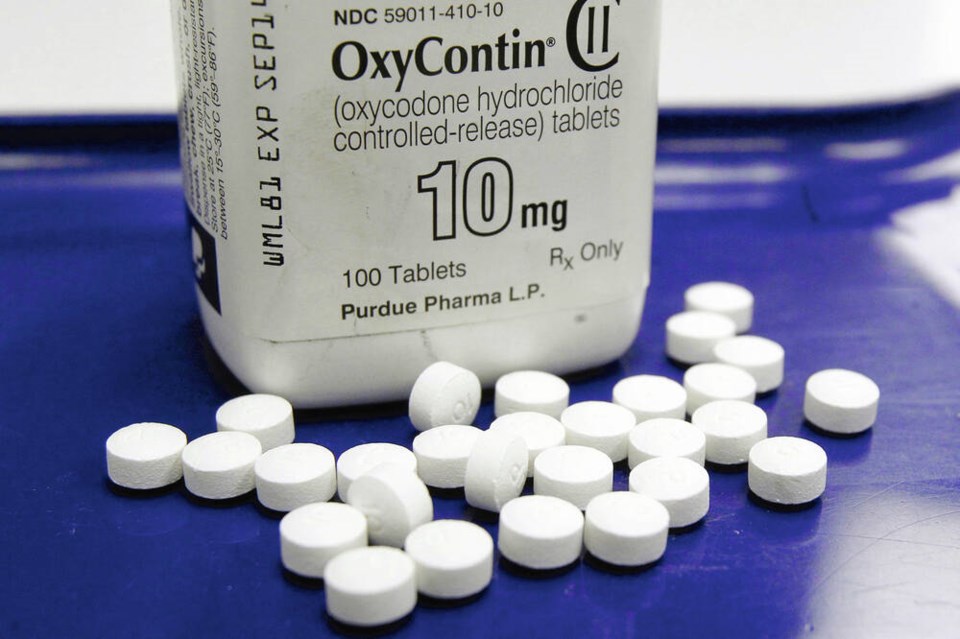On behalf of Canada’s federal, provincial and territorial governments, B.C. has negotiated a settlement with the drug company Purdue Canada.
The settlement, for $150 million, is the largest of its kind in Canadian history. It stems from allegations that Purdue made misleading claims about OxyContin, an opioid painkiller developed by the company.
Additional class action suits are still in the drafting stage.
Purdue allegedly minimized the risk of addiction associated with the drug, in the process helping launch the opioid addiction catastrophe that is afflicting communities across Canada, and around the world.
The $150 million will be used to help mitigate the health-care-related costs of fighting a pandemic that killed more than 30,000 Canadians between 2016 and 2021, and continues to grow.
To understand fully the shocking behaviour of Purdue, it helps to look at settlements already negotiated in the U.S.
These detail uncontested evidence of a massive campaign to cover up the addictive qualities of OxyContin, and encourage physicians to prescribe it by offering such inducements as all-expenses-paid trips to company-sponsored events. More than 5,000 physicians, pharmacists and nurses attended these marketing seminars.
A compact music disc titled Get in the Swing with OxyContin was released, and the company compiled a database of physicians who were high prescribers of their drug.
While these profiles identified doctors with large numbers of chronic pain patients, it also singled out the least discriminate prescribers who might be susceptible to Purdue’s sales techniques.
It worked. Purdue’s physician contact list increased from about 40,000 in 1996 — the year OxyContin was introduced — to upward of 90,000 in 2000.
Through sales representatives, free time-limited prescriptions covering a seven- to 30-day supply were offered to patients. This might have been expected to broaden the range of ailments treated with the opioid, and it did just that.
The campaign caused a ten-fold increase in the use of OxyContin for non-cancer-related pain, from about 670,000 prescriptions in 1997, to 6.2 million five years later.
There is incontrovertible evidence of astonishing abuses. In the small town of Kermit, West Virginia, population around 350, some 12 million opioid pills were sold.
Yet trials of OxyContin, and its slow-release version Oxycodone, showed only small to modest pain relief compared with less addictive medications.
Most problematic, Purdue consistently assured doctors that the risk of addiction from OxyContin was extremely small. The company instructed its sales representatives to tell physicians that the addiction rate was “less than one per cent.”
But studies have shown that the prevalence of addiction in chronic-pain patients could be up to 50 per cent, depending on the patients studied.
What emerges here is a picture, albeit imperfect, of how opioid addiction became the catastrophe we see today. For as news of the true addictive qualities of drugs like OxyContin slowly gained prominence, physicians began cutting back on prescribing opioids for non-cancer-related pain.
But with a large user group now recruited, it was predictable that some patients cut off from their supply would turn elsewhere. This was, in part, the genesis of the fentanyl crisis.
In its street form, fentanyl is 100 times more powerful than morphine, and much more addictive than prescription opioids. It is also far more dangerous.
Last year 2,224 British Columbians lost their lives to street drugs, of which fentanyl was the lead component. Across the province, illicit drug deaths are now second only to cancer in years of life lost.
The settlement negotiated by B.C., while an important step forward, comes nowhere near offsetting the costs now faced by Canada’s health-care system as a result of the opioid catastrophe. While further class-action suits may redress some of the wrongdoing, sadly they will come too late to avert what must be considered among the worst man-made health-care disasters ever recorded.
Purdue and other drug companies sowed the wind. We are all reaping the whirlwind.
>>> To comment on this article, write a letter to the editor: letters@timescolonist.com



